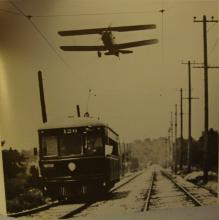


Interubans were mostly, but not exclusively, Midwest phenomena, existing between about 1900 and 1930. By 1930 the Great Depression, cheaper cars, and more and better roads, put most interurban systems out of business, and those same forces were beginning to affect railroad passenger service. Only WWII kept railroad passenger service viable for another decade or so. In their heyday, one could ride interubans great distances, as shown in a map of the southern Michigan interurban system below.
Left click on the image below for a larger version.
A famous publicity photo - if only in interurban circles - shows an interurban car outpacing a biplane, doing something like 97 miles per hour in the process. Although not always geared in that way, interurban cars could indeed go very fast in open, flat areas.
The extent of the interurban system in lower Michigan in and around the mid 1920s can be seen in the image below.
Left click on the image below for a larger version.
There were apparently plans for many more lines, as shown in the image below, from about 1915. Of the proposed lines, how many were serious proposals, ready for work to commence, and how many were less serious, is not known. But in principle there could have been a truly comprehensive network of interurban lines in the Michigan LP, capable of taking people just about anywhere. But political and commercial forces conspired to make it certain that none of the lines would be built, and never can be now.
Left click on the image below for a larger version.
Three interurban systems started - or, depending on your point of view, ended - in Grand Rapids. The map below shows the three systems, the Grand Rapids to Kalamazoo, the Grand Rapids to Holland and Chicago, and the Grand Rapids, Grand Haven, and Muskegon.
Left click on the image below for a larger version.
The inland route indicated, meaning no Grand River crossings for the two southern routes, did not happen for some reason. Perhaps because it would have required a number of crossings over the Grand Rapids and Indiana and the New York Central tracks, which would have required expensive trestles. Or perhaps it was because a bridge across the rive was required in any case for the Grand Rapids, Grand Haven, and Muskegon line.
At its peak one could get to most of the major cities in lower Michigan by interurban. By the late 1920s automobiles were beginning to have a dramatic affect on interurban and passenger train ridership, and many interurbans failed. The Division Avenue Bus Line began in the 1920's, provided the transportation between about 68th Street and Grand Rapids left vacant when the interurban went bankrupt in 1928.
In many states the interurban right of ways were shared with power company transmission facilities. It is no coincidence that the Grand Rapids to Kalamazoo track is now occupied by high voltage towers. The tracks themselves were torn out and sold, with the exception of a few streets, where they were simply paved over. Hills existed on 34th and maybe 35th streets up through at least the 1950's. When the roads were leveled later on the rails and track ties were still there.
During their period of operation, interurbans were not allowed to cross standard
railroad tracks at grade level. So elaborate tresses had to be built to get
the interurban cars up and over any railroad tracks, and provide enough clearance
for the trains to go under them. The trestles were large, probably expensive,
and typically made of wood, as the ca. 1910 photograph of an interurban climbing
a trestle near Galesburg, MI, shows. Interurban motors were quite powerful, and
unlike standards railroad trains, interurban cars could negotiate substantial
inclines.
Left click on the image below for a larger version.
The Grand Rapids to Kalamazoo line used a steel section of bridge to cross 28th street and the Grand Rapids and Indiana Railroad track.
Left click on the images below for larger versions.
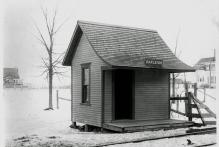
|

|

1905 - unknown location. |
Left click on the images below for larger versions.

Waiting room - Indianapolis - 1905. |
Left click on the images below for larger versions.

|
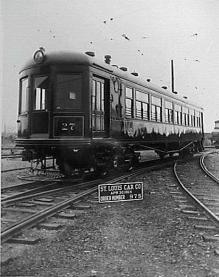
|

|
Above, an interurban coach - built 1914 for Michigan United Traction Company. The image above, right, shows the interior. At the right, in front, is a sign saying "St. Louis Car Co." Lower down, one could buy the Grand Rapids Herald for 3-cents. The seats were covered in leather, and appear to be quite comfortable. On the larger cars, a smoking section was located at one end of the car.
Left click on the image below for a larger version.
As is always the case, the rich and wonderful, and-or the bigwigs at a company, could travel in a style unavilable to those of lesser means. The custom coach shown above is a private car named Josephine. It was built in 1903, and allowed the important person a wonderful view out a large window. Looking at the chair, it's not clear whether slaves fed the important person grapes or wine.
The interurban track that ran south, west of the old Rackett swimming pool (apparently filled in as of year 2000), started operation in 1916, and ceased operation in 1928.
In route, the interurbans on this line sometimes reached speeds of over 80 miles per
hour. The tracks were built to heavy rail standards - 80 pound rails - and the
route between
Grand Rapids and Kalamazoo was straight much of the time. The coaches were
up to 70 feet long, weighed as much as 67 tons, and were among the largest
used on any of the numerous interurbans of the time. Below is an article from
the May 16, 1914, issue of "Electric Railway Journal" describing the coaches
on the Grand Rapids - Kalamazoo line.
Left click on the images below for larger versions.
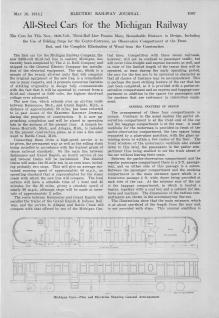
|

|
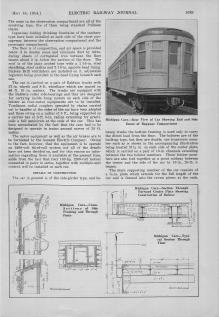
|
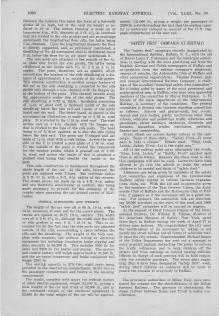
|
Left click on the images below for larger versions.

|

|
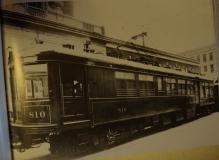
By Pantlind Hotel. |
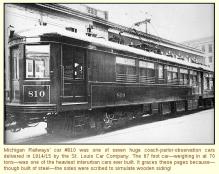
By Pantlind Hotel. |

Pantlind Hotel - 2012. |
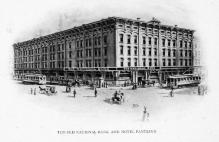
|
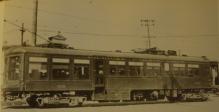
|

The image above shows a car on a Jackson/Battle Creek line, but it's
likely that the Grand Rapids/Kalamazoo line was very similar in appearance.
One can see the third rail on the bottom far right of the photograph. In the
more practical, less densely populated world of the 1915 to 1930 time
period, a rail with 1,200 volts of D.C. was tolerated. Lethal, fences
apparently did exist in many places in an attempt to keep people off the
right of way. Built in 2004, if the land could be found, an OSHA
approved electric interurban would be hopelessly expensive.
Left click on the images below for larger versions.
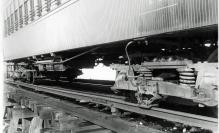
|
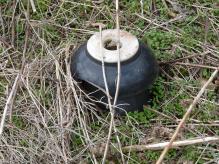
|
The photograph above, left, shows the shoe arrangement for the third rail. They were designed in such a way as to strip ice from the rail in the winter, and only one had to make contact with the rail in order for the car to move forward. This helped the car to get across breaks in the third rail - at depots for example.
Above, right, is an insulator on which the third rail was mounted. This one was found a ways south of 122nd Street, as the street numbers come out of Kalamazoo, on the Grand Rapids - Kalamazoo line. These are still commonly found along the right of way after 86 years, albeit it is less common to find one today that is not broken in some way. Apparently salvagers had no use for them and just tossed them to the side of the right of way. No doubt collectors have now gathered whatever unbroken ones that still exist.
It's possible that the interurban had an effect on the development of the area along Division Avenue, between about 28th and 44th Streets. Starter buildings, located near 32nd Street just south of the old Burger King, and near about 42nd Street, sitting by themselves, and intended to be the nucleus of rows of stores, like the old Burton Heights, Many of the streets in this same area were begun in the 1910 to 1920 time frame. It's likely that the intent was to use the interurban to get people to and from work in Grand Rapids. The stretch between 28th and about 44th streets was in reality a large real estate development effort, but until 1936 there was not a great deal of industry in the area.
For a capsule summary of the Michigan Electric Railway company, a view of what the Grand Rapids to Kalamazoo interurbans looked like, and a fascinating description of what happened to many of them, see Michigan Electric Railway #28. The story is similar in other states, and a number coaches have been spared total oblivion by spending years as cottages, restaurants, chicken coops, and storage sheds. Car 28 was used as a cottage. That, and the ingenuity, imagination, and skill of those railroad museum workers who have restored and rebuilt what is left of many. The photographs below show a few more views of Michigan Electric 28 during the process of restoration.Left click on the images below for larger versions.
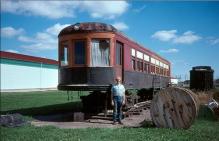
Standing, Norm Krentel |

|
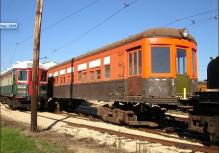
|
Orange paint is being applied in the left hand photograph.
It was decided at some point in time that orange was the easiest color to see,
and it became the standard color for interurban coaches, in part or in full.
The photos below show some roof line work done and being done on coach 28 at the Illinoise Railway Museum,
about July 28, 2014.
Left click on the images below for larger versions.
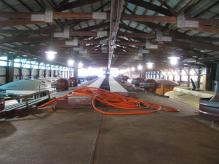
|
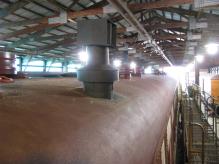
|
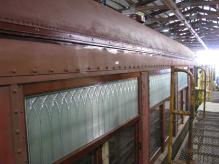
|
Left click on the images below for larger versions.
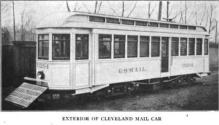
|
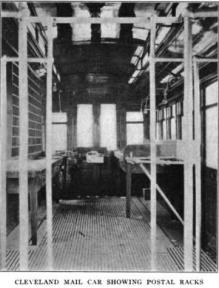
|
A mail car used on the Cleveland Electric Railway, in an April 11, 1908, photograph. The inside was set up like a standard railroad mail car. A mail contract would have provided good income for the line, and in later years even kept some railroad passenger trains running.
Left click on the images below for larger versions.
Left click on the image below for a larger version.
In other cases, a complete coal fired power plant was used. A generating station in Fruitport, MI, is shown below.Left click on the images below for larger versions.
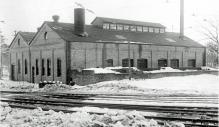
|

|

|
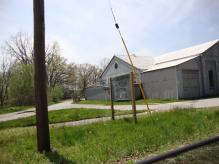
|

|
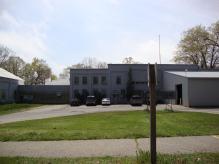
|

Water tower. |
Left click on the image below for a larger version.
Whether this 1902 photograph is the inside of the Fruitport plant is not known here. These plants had to run, or at least be on standby, 24 hours a day, even when there was not much revenue being generated by the line. Being relatively low voltage D/C, the power did not travel far, and these "sub stations" had to be located at many places along a line.Left click on the image below for a larger version.
January 25, 1908
Left click on the image below for a larger version.
One can sense the huge size of the power plant in the photograph above of the Farmington, MI, plant. The role of central power plants was still evolving. It was probably not realized how expensive it would be, on a cost per kilowatt basis, to run a plant like this. Sadly, the means were not available in the early days of the interurban to use A/C power, and home power was only becoming common. When the means to run interurbans directly on A/C became available, it was both too late because of a changing world, and and too expensive to do a retrofit.
When power became available from the Croton and Rogers dams, and later, Hardy Dam, it was used to power the GR_M_H line. The stand alone power stations were then used as standbys, no doubt at huge cost. Sadly, the line would have been profitable with as few as 5 passengers or so per run but for the huge overhead costs, including power and interest on construction costs. The line's power plants were too small to be of interest to a power company, yet required 24/7 operation even to serve as backup power. Sadly, central power companies were just coming into their own at this time, and even residental power was new and novel
Power for the Grand Rapids - Kalamazoo line apparently used a set of what were for the time
quite high volage lines - 72,000 to 110,000 vots. There was an interplay between the power
companies of the day and the interurban lines. In 1915 or so, when the line was being built,
houses, towns, factories, etc., were only beginning to be wired. Power companies built dams,
and then had to figure out what to do with the power.
For now, it appears that Consumer's Power built a transmission line between
Grand Rapids and Kalamazoo with the express intent of suppying power to the interurban line.
The piece on the left, below, explains some of this:
Left click on the images below for larger versions.
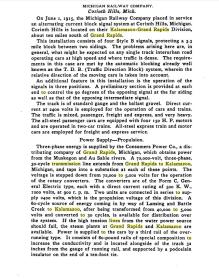
June 1, 1915. |
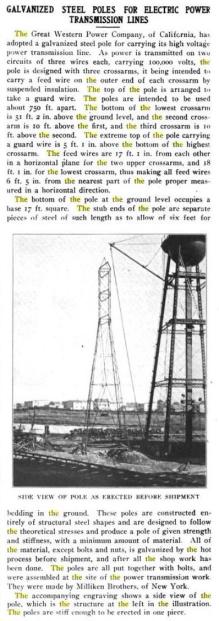
Three phase towers - 1908 |
The piece states the line could use power supplied by way of Lansing and Battle Creek, which was apparently also generated by dams. In the event the dams could not supply the power, say in the late summer months, steam power plants at the Grand Rapids and Kalamazoo ends of the line could provide backup power. At points along the line substations would convert the A/C to D/C, albeit at a large cost, but A/C interurban systems simply weren't available at the time. Even the Boston MTA used D/C well into the 1960s, and might well yet - 660 volts, which is surpisingly close to the voltage used by the interurban systems some 40 to 60 years earlier.
This all makes sense, whether it is exactly right. It is unlikely the power company lines would follow just the route they do but for the needs of the interurban cars. Whether the transmission towers one sees today are the original ones is not completely clear, but photographs of the interurban depots suggests they are. And once the interurban failed, the power company simply kept the right of way and the lines, which are valuable in their own right in a day when it is almost impossible to site either a railroad track or a transmission line because of all of the legal hoops.
The situation seems to be that there was complicated interplay between the interurban systems and the power companies - it's even possible that in some cases the interurban lines provided a rallying point for evolving power companies, since the interban lines were the only thing for a while that used any appreciable amount of electricity. In true chicken and egg fashion, once the power was available, other uses were quickly found, and the same lines that provided power for the interurban lines could supply other uses. In time, higher capacity generating facilities and higher capacity power lines were needed, leading to the systems we have today.
The piece on the right, above, shows steel towers, called poles in their day, being preassembled before shipment. Two sets of three-phase power were accommodated, witht the "guard wire," or ground, along the top of the towers. Towers like these were used along the GR - Kalamazoo line, and carried 72,000 to 100,000 volts, quite advanced for 1915. In the early 1950s the towers carried lines with 150,000 volts. One could hear the corona buzz. Galvanized, the towers appear to be in excellent condition on that line, now after almost 100 years.
Left click on the images below for larger versions.
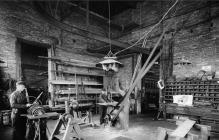
Fruitport, MI. |
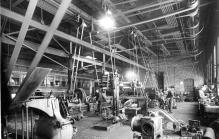
Fruitport, MI. |
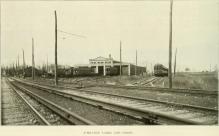
Wheaton, IL - yards and shop, 1905. |
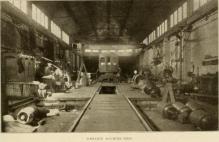
Wheaton, IL - shop interior, 1905. |
Left click on the image below for a larger version.
The photograph above shows an inspection house in Muskegon. Seeing the many brooms, the coaches were probably cleaned out as well as generally inspected for road worthiness.
The decline of the interurbans came suddenly, victims of both the Great Depression and the rise of the automobile. Partly the product of the kind of investment fad that was so common during the construction era of the railroads, when enthusiasm often got ahead of good business sense. So the interurbans had little financial cushion when competition from the automobile and a failing national economy started to put pressure on ridership.
Many lines went bankrupt, and were sold for scrap. The coaches were often sold for a dollar, sans motors and trucks. Still others were burned, to get access to any metals of value, a fate suffered by many trolleys too. Below are examples of what happened to some of them.
Left click on the images below for larger versions.

|

|
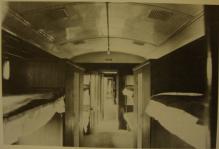
|
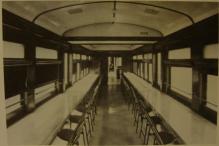
|
Left click on the image below for a larger version.
The photograph above shows a steel bridge on the Grand Rapids, Grand Haven, and Muskegon line. It's hard to say what the orgin of the bridge is. It appears to be a standard railroad bridge, which would suggest overkill for most interurban lines. And this bridge only crosses a road.
Various lines were built to all different standards. The line from Grand Rapids to Kalamazoo was built to standard railroad specifications, because the cars sometimes weighed 85 tons, which was about the weight of a railroad passenger coach of the time. Others were simply light rail. Typically the coaches were bigger than streetcars, but not as heavy as the GR to Kalamazoo coaches, and could use lighter rail.

